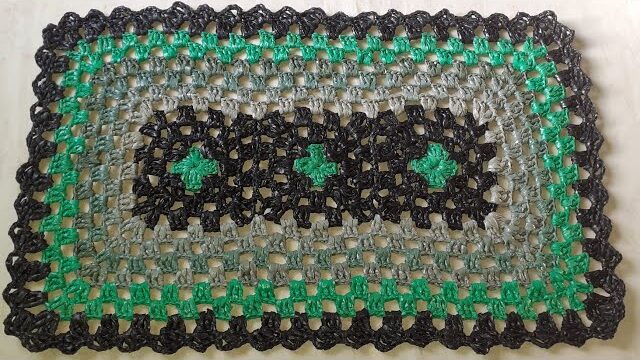Anúncios
Turning grocery bags into crochet rugs is a creative and sustainable way to reuse materials that would otherwise be thrown away. In addition to being a fun craft project, it is a great way to practice recycling and give new life to items that are usually thrown away. In this guide, you will learn the step-by-step technique to create unique rugs using plastic bags.

Necessary Materials
To start your recycled rug project, you will need the following materials:
- Grocery bags (preferably clean and dry)
- Scissors
- Crochet hook (size may vary depending on your preference)
- Thread or yarn for crocheting (optional, depending on the desired finish)
The choice of plastic bags is important. Colorful plastic bags can add a vibrant touch to your rug, while white or clear bags provide a more neutral, clean look.
Preparing the Bags
Before you start making your rug, you need to prepare your grocery bags. Here’s how you can turn them into useful plastic strips for crocheting:
- Cleaning the Bags: Make sure the bags are clean and dry. Wash them if necessary and let them dry completely before beginning the process.
- Cutting the Bags: Take a plastic bag and cut it into strips. The width of the strips can vary, but generally, strips about 2 to 3 cm wide work well. If you prefer, you can join the strips of plastic bag together to form a continuous string.
- Union of Strips: To join the strips together, you can simply tie them or sew them together. Bring the ends of the strips together and tie a knot or use a seam to hold the strips together, forming a continuous thread for your rug project.
Crochet Technique
Now that you have your bag strips ready, it’s time to start crocheting your rug. Below, you’ll find a basic step-by-step guide to help you create your recycled rug.
- Project Start: Make a starting knot with the plastic strip and start making chains. The length of the chains will depend on the size you want your rug to be. Generally, 20 to 30 chains is a good starting point.
- Formation of the First Rows: Work single crochet (or another stitch of your choice) in each chain, until the end of the row. Turn the work and make another row of single crochet over the previous row.
- Continuation of Work: Continue adding rows until your rug reaches the desired size. Remember to keep the tension even to ensure the rug has a consistent look.
- Finish: When the rug is the desired size, finish the job with a finishing stitch and cut off the excess plastic strip. If desired, you can add a decorative border or trim around the rug for a finishing touch.
Customization Tips
To make your rugs even more unique, consider the following customization tips:
- Color Mixing: Try using different colored bags to create interesting patterns and designs on your rugs. You can alternate colors or create stripes and color blocks.
- Texture and Size: Play with the texture and size of your rugs by adjusting the width of your strips and the tension of your crochet. This can create different visual and tactile effects in your recycled rugs.
- Adding Details: Add details like borders or patterns with additional threads or recycled fabrics for a more elaborate look.
Benefits of Recycling
Making rugs out of grocery bags is an effective way to recycle materials and reduce waste. Recycling plastic bags to create useful and beautiful items not only helps reduce solid waste, but also contributes to protecting the environment. Plus, it’s a craft activity that can be done at home, providing a rewarding way to practice sustainability.
Making rugs from grocery bags is a great way to practice recycling and explore your creativity. In addition to transforming waste into a functional and decorative item, you’re also helping to reduce your environmental impact. By following this step-by-step guide, you can make your own recycled rugs and customize them to suit your style and preferences. Experiment with different colors and patterns to create unique and sustainable rugs for your home.
Learn how to make other arts by recycling, Click here.
Check out interesting facts about recycling clicking here.




